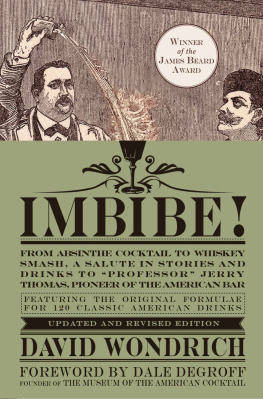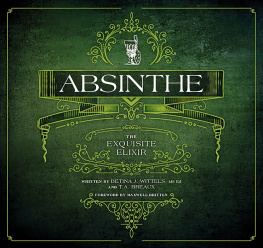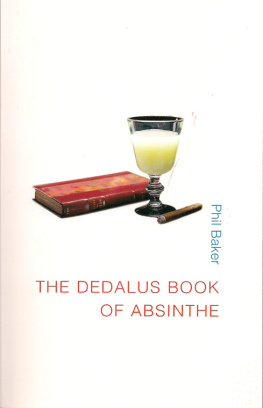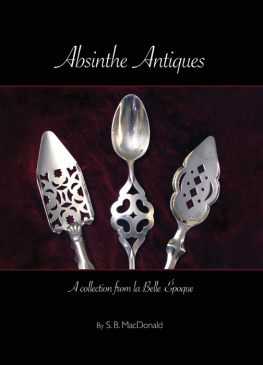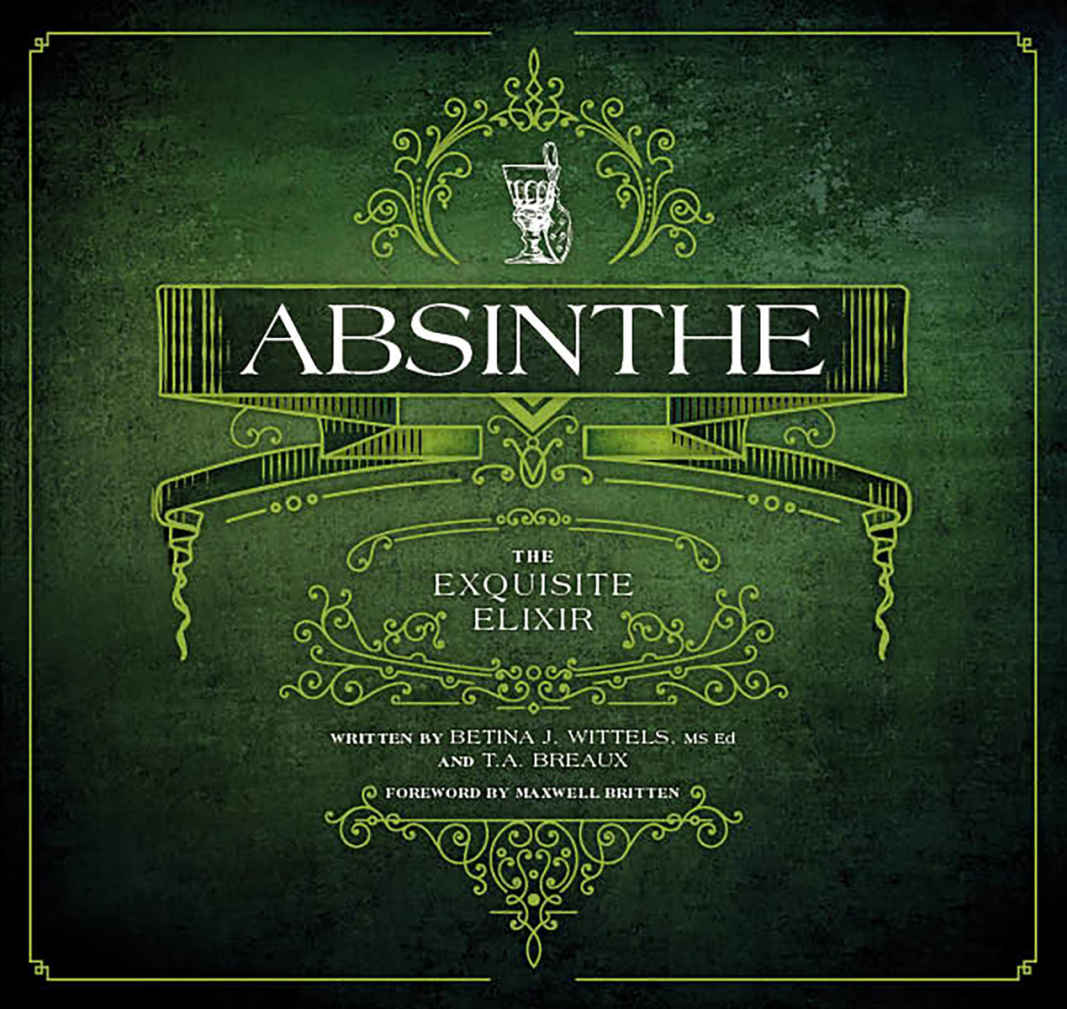

Nineteenth-century stills in the Combier distillery, Saumur, France

Text @ 2017 Betina J. Wittels and T.A. Breaux
All rights reserved. No part of this book may be reproduced or transmitted in any form or by any means, electronic or mechanical, including photocopying, recording, or by an information storage and retrieval system except by a reviewer who may quote brief passages in a review without permission in writing from the publisher.
Library of Congress Cataloging-in-Publication Data
Names: Wittels, Betina J., author. | Breaux, T. A., author.
Title: Absinthe : the exquisite elixir / Betina J. Wittels, T.A. Breaux.
Description: Golden, CO : Fulcrum Publishing, 2017.
Identifiers: LCCN 2016047036 | ISBN 9781682750018 (paperback)
Subjects: LCSH: Absinthe. | Absinthe--Social aspects. | Drinking customs-History. | BISAC: COOKING / Beverages / Wine & Spirits. | COOKING / History.
Classification: LCC GT2898 .W58 2017 | DDC 394.1/3--dc23
LC record available at https://lccn.loc.gov/2016047036
Fulcrum Publishing has made its best efforts to locate and credit original sources for the artwork used in this book. Please contact us if we have made any errors or omissions.
Photo credits: From the collection of T.A. Breaux ().
Fulcrum Publishing
4690 Table Mountain Dr., Ste. 100
Golden, CO 80403
800-992-2908 303-277-1623
www.fulcrum-books.com
Dedication
This book is dedicated to the late Mike Iavarone, for without his guidance this absinthe journey would never have begun. I could never even whisper that this book was inspired by me alone. Adventurous as I am, this book would have never come to exist without the beings named hereafter. Besides the Green Fairy, who literally flung me into her realm and traipsed next to me through more than several continents, barrios, pueblos, bodegas, brocantes, markets, and villages, are those who led, nudged, comforted, taught, and helped me in every possible way. To these friends, mentors, customers, associates, collectors, dealers, and guides, I offer my humble gratitude.
- Betina J. Wittels, MS Ed
This book would not have been possible without the assistance of Franck Choisne, Jared Gurfein, Peter Schaf, Jenny Gardener, my friends and associates from around the globe, and the enduring patience of my wonderful family.
T.A. Breaux
Acknowledgments
A special thank you to Cary Ren Bonnecaze for the countless antiques and photos he provided, as well as the time he spent helping us bring the book to publication.
Additional thanks to:
Franois Bezenon B.J. Bordelon Ray Bordelon Eric Brempell Susan Brown Paolo Castellano Ryan Clark David Clemmer Patrice Cordier Bernard Cousin Aaron DeFoe Jill DeGroff Franois Guy Nicole Hanson Mike Iavarone Nick Letson Eric Longuet Peggy Martin Norman Nichols Dan Noreen Patrick OConnor Chris Peery Father Patrick J. Perez Eric Przygocki Steve Rosat Jennifer Shelton Ana Strecyzn Monica and Claude Talluel Tracy Thomas Diane Tripet Matthias Wohlwend God, and the Green Fairy

One of four black cat postcards that promote the allegedly docile Quality of Absinthe Bourgeois
CONTENTS

The bar at Maison Premiere, Brooklyn, New York
FOREWORD
Maxwell Britten
W hen I was younger, I was lucky enough to have friends who had cultivated a taste for quality, or at least what we thought were the finer things. At the young age of eighteen, in between watching Ian Curtis biopics and collecting post-punk records, we discovered a vendor in the Czech Republic who was selling homemade absinthe kits. After mailing a handwritten money order to somewhere in Europe and a two-month wait, our kit finally arrived. At the time, we thought we were onto something. Even now, I cant adequately express what exactly happened after we drank it. Lets just say those absinthe kits were nothing but cheap, high proof alcohol with skimpy bags of dried herbs and licorice. We were drinking the wrong absinthe, and we were drinking it the wrong way.
My taste for real absinthe evolved only with my maturity. In retrospect, its amusing to reflect on everything I didnt know about absinthe, considering the volume of knowledge I would eventually accrue.
My father is a restaurateur, which means I grew up in restaurants. I started to put in my time behind the bar while simultaneously developing a personal relationship with art and culture. To me, these two worlds were separate and compartmentalized. I barbacked and bussed tables so I could support my habit of books, records, and crazy absinthe kits. And that first sip of our homemade absinthe the most intense and blinding firewater Id ever tasted was enough of a fiery inspiration for me to plant myself in New York City, that ocean of history and pop culture in which I had to immerse myself. After only a short time in the city, I encountered places that were beginning to take the craft of the cocktail more seriously. I saw people make drinks with precision and technical prowess. There was a level of ceremony occurring behind the bar that Id never before witnessed, and it spoke to me like nothing else had. I began making the connection that pop culture, art, and what I did to pay the bills were not mutually exclusive. My interest in literature shifted to reprints of antique cocktail manuals, and books focused on spirits, bars, and cocktails. I became obsessed.
As I continued to study and hone my bar skills, the subject of absinthe continued to surface. It was always called for in vintage recipes and must know drinks such as the Sazerac, but only in scant amounts a couple of drops here and a rinse there. Occasionally I would have customers whod spent time abroad come into my bar and ask for absinthe, served Czech style (flamed). Being someone who tries to avoid the word no, I aimed to please, but something still seemed off. When I was asked to serve absinthe this way, the reasoning behind these steps of service always baffled me. Most of the time I was doing this with pastis or some other absinthe alternative, as the genuine article wasnt legal in the United States. Soon after these episodes of fire and vapor, genuine absinthe was relegalized after being banned for almost a century. Yet even when we finally got the real McCoy, most people still didnt know what to do with it or how to order it, and the charade continued.

Maxwell Britten
Absinthe had been stigmatized by its ban and its own nebulous history. This became problematic in the late twentieth century, when many faux versions of it were sold as illicit, evil, and hallucinatory elixirs to anyone willing to be coaxed into a shot of high proof alcohol, set on fire. But once absinthe was legal and available, many people in the United States had loads of questions. As a bartender who was trying to take my work seriously, I had to get the answers, and they werent easy to come by in the early days.


